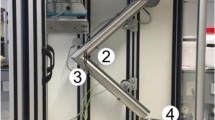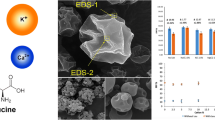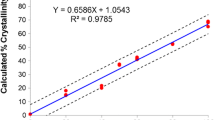ABSTRACT
Purpose
This study aimed to characterize inherent charge generated by micron-sized drug-only formulations of amorphous and crystalline salbutamol sulfate (SS).
Methods
Amorphous SS was produced by spray-drying whilst crystalline SS was produced by conditioning spray-dried SS with supercritical CO2 and menthol. Electrostatic charge of the powders was characterized in two ways. Firstly, the charge profile of the aerosols dispersed from an Aerolizer® was measured using a modified Electrostatic Low Pressure Impactor (ELPI™). Secondly, the net charge of the bulk powders generated from tumbling in containers composed of different materials (polyethylene, polyvinyl chloride, Teflon, nylon and stainless steel) was measured by a Faraday pail.
Results
Following aerosolization, crystalline SS appeared to show more consistent charging and mass deposition than amorphous SS. In the tumbling experiment crystalline SS had a significant correlation between net charge and work function, which was absent in amorphous SS. This may be due to the long-range crystal packing which was reflected as more predictable charging. In addition, the polarity of charging was attributed to the arrangement of SS molecules in the crystal lattice.
Conclusions
The effect of crystallinity on the electrostatic charge behavior of inhalable micron-sized spherical drug particles with well-defined particle size distribution was investigated for the first time. The knowledge gained may assist in the development of optimized inhaled pharmaceutical products.







Similar content being viewed by others
Abbreviations
- AFM:
-
Atomic force microscopy
- BET:
-
Brunauer, Emmett and Teller
- DPI:
-
Dry powder inhaler
- DVS:
-
Dynamic vapor sorption
- ELPI:
-
Electrostatic Low Pressure Impactor
- FID:
-
Flame ionization detection
- GC:
-
Gas chromatography
- HPLC:
-
High performance liquid chromatography
- RH:
-
Relative humidity
- Rq :
-
Root mean squared
- scCO2 :
-
Supercritical CO2
- SDS:
-
Sodium dodecyl sulfate
- SEM:
-
Scanning electron microscopy
- SS:
-
Salbutamol sulfate
- XRD:
-
X-ray diffraction
REFERENCES
Wong J, Chan H-K, Kwok PCL. Electrostatics in pharmaceutical aerosols for inhalation. Ther Deliv. 2013;4:981–1002.
Byron PR, Peart J, Staniforth JN. Aerosol electrostatics I: properties of fine powders before and after aerosolization by dry powder inhalers. Pharm Res. 1997;14:698–705.
Telko MJ, Kujanpaa J, Hickey AJ. Investigation of triboelectric charging in dry powder inhalers using electrical low pressure impactor (ELPI). Int J Pharm. 2007;336:352–60.
Kwok PCL, Chan HK. Effect of relative humidity on the electrostatic charge properties of dry powder inhaler aerosols. Pharm Res. 2008;25:277–88.
Young P, Sung A, Traini D, Kwok P, Chiou H, Chan H-K. Influence of humidity on the electrostatic charge and aerosol performance of dry powder inhaler carrier based systems. Pharm Res. 2007;24:963–70.
Karner S, Anne Urbanetz N. The impact of electrostatic charge in pharmaceutical powders with specific focus on inhalation-powders. J Aerosol Sci. 2011;42:428–45.
Kwok PCL, Chan HK. Electrostatics of pharmaceutical inhalation aerosols. J Pharm Pharmacol. 2009;61:1587–99.
Murtomaa M, Harjunen P, Mellin V, Lehto V-P, Laine E. Effect of amorphicity on the triboelectrification of lactose powder. J Electrost. 2002;56:103–10.
Kwok PCL, Chan HK. Solid forms and electrostatic properties of salbutamol sulfate. In Dalby R, editors. Respiratory drug delivery, vol. 3, River Grove; 2008, pp. 919–22.
Adi H, Kwok PCL, Crapper J, Young PM, Traini D, Chan H-K. Does electrostatic charge affect powder aerosolisation? J Pharm Sci. 2010;99:2455–61.
Muhammad SA, Langrish T, Tang P, Adi H, Chan H-K, Kazarian SG, et al. A novel method for the production of crystalline micronised particles. Int J Pharm. 2010;388:114–22.
Xie S, Poornachary SK, Chow PS, Tan RBH. Direct precipitation of micron-size salbutamol sulfate: new insights into the action of surfactants and polymeric additives. Cryst Growth Des. 2010;10:3363–71.
Gallo CF, Lama WL. Classical electrostatic description of the work function and ionization energy of insulators. IEEE Trans Ind Appl. 1976;12:7–11.
Zeng XM, Martin GP, Marriott C. Particulate interactions in dry powder formulations for inhalation. London: Taylor and Francis; 2003.
ACKNOWLEDGMENTS AND DISCLOSURES
The authors thank Ms. Ellen Braybon from Faculty of Chemistry, University of Sydney, for providing instrumental facilities and assistance for GC analysis; the Australian Microscopy & Microanalysis Research Facility, University of Sydney, for providing facilities for SEM imaging; Mr. David Cipolla from Aradigm Corporation for feedback on the manuscript, and Dr. Dai Hibbs from the Faculty of Pharmacy, The University of Sydney, for valuable discussions. This research was supported under Australian Research Council’s Discovery Projects funding scheme (project numbers DP120102778 & 110105161).
Author information
Authors and Affiliations
Corresponding author
Additional information
An erratum to this article is available at http://dx.doi.org/10.1007/s11095-017-2125-3.
Rights and permissions
About this article
Cite this article
Wong, J., Kwok, P.C.L., Noakes, T. et al. Effect of Crystallinity on Electrostatic Charging in Dry Powder Inhaler Formulations. Pharm Res 31, 1656–1664 (2014). https://doi.org/10.1007/s11095-013-1270-6
Received:
Accepted:
Published:
Issue Date:
DOI: https://doi.org/10.1007/s11095-013-1270-6




